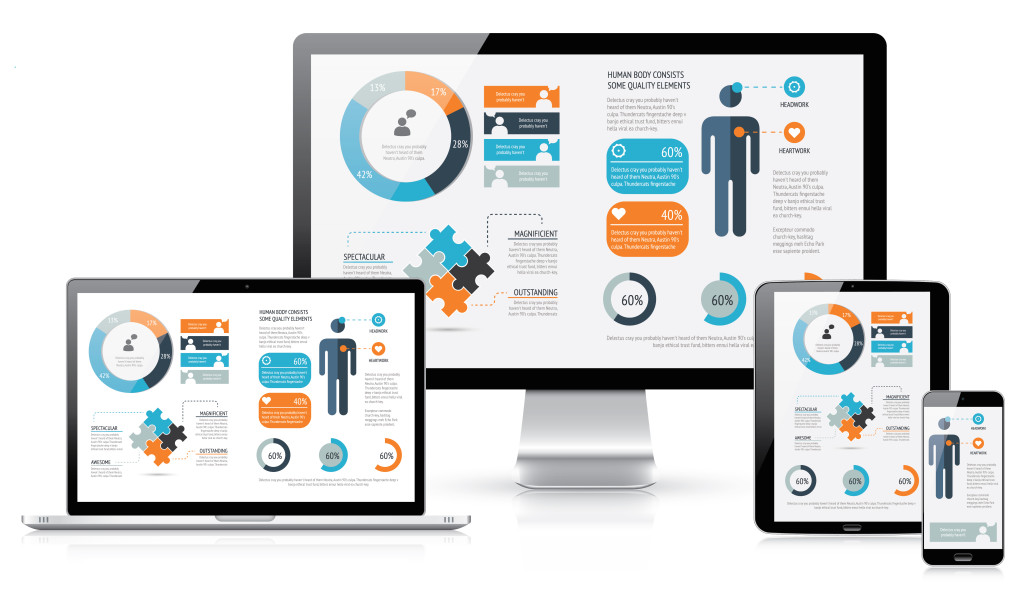A Comprehensive Overview to Responsive Website Design Techniques
Receptive website design has become an essential element in the development of electronic platforms, enabling for a seamless individual experience across a wide variety of devices. This overview will certainly check out crucial strategies such as fluid formats, media queries, and photo optimization that contribute to efficient responsive style. By understanding these principles, developers can create web sites that not only adapt visually yet also boost individual involvement. However, the landscape of website design is continuously advancing, questioning about the future of responsiveness and the methods that will certainly define it.
Comprehending Receptive Website Design
Receptive internet style (RWD) is a technique that makes sure a web site's format and web content adjust effortlessly throughout a range of gadgets and screen sizes (Web Design Pretoria). This design methodology is important in today's digital landscape, where users access websites from smart devices, tablet computers, laptop computers, and desktop. RWD enhances customer experience by permitting a web site to preserve functionality and aesthetic appeals, despite the device being utilized
A key part of RWD includes fluid grids that use family member systems, such as portions, instead than dealt with units, to specify layout components. This versatility enables images, message, and other parts to resize proportionally, supplying an ideal watching experience. Furthermore, media queries are used to use various styles based upon gadget qualities like display width and orientation. This technique guarantees that the website's style is tailored to the details requirements of customers, improving use.
In addition, RWD contributes favorably to search engine optimization (SEO) by advertising a single, constant link for a website, which simplifies web link sharing and indexing. As mobile tool usage proceeds to rise, recognizing and implementing responsive internet design is important for services intending to reach a wider target market and improve general web performance.
Trick Concepts of Responsive Design
To create an effective receptive layout, numerous vital concepts need to be taken into consideration. This indicates creating for the smallest screens first and considerably boosting the format for bigger tools.
2nd, versatile grids and designs are important. Utilizing a grid system that adapts to various display dimensions permits a harmonious distribution of content, ensuring readability and use throughout devices. This adaptability is enhanced by the use family member units, such as ems or percents, instead of taken care of pixels.

Lastly, focusing on material power structure is necessary. Clear and logical company of web content boosts customer experience, assisting site visitors with the website flawlessly, no matter the gadget utilized. Web Design Pretoria. By sticking to these concepts, designers can create websites that are not only aesthetically appealing but user-centered and also practical throughout all devices
Techniques for Fluid Layouts
Liquid designs are necessary for developing adaptive internet experiences that perfectly adapt to numerous display dimensions. By using percentage-based sizes rather than repaired pixel worths, developers can make sure that elements on a website resize proportionally, maintaining aesthetic harmony across gadgets. This strategy advertises adaptability, allowing material to flow and adjust as the viewport adjustments.
One efficient approach for attaining fluid designs is to employ CSS Flexbox or Grid anchor systems. These CSS modules enable programmers to create responsive structures that can quickly resize and rearrange based upon the available room. Flexbox masters one-dimensional formats, while Grid is perfect for two-dimensional arrangements, providing higher control over positioning and placement.
Another technique involves making use of media queries to specify breakpoints where modifications are required - Web Design Pretoria. By defining read more different styles for numerous display sizes, developers can customize format residential properties dynamically, ensuring optimum usability and visual allure
In addition, including family member systems like ems or rapid eye movements for font dimensions and spacing can further improve fluidity, as these units range based upon user setups or moms and dad aspects. With each other, these techniques promote the advancement of fluid layouts that promote an appealing customer experience across varied tools.
Maximizing Pictures for All Instruments
Photos play an important duty in internet style, and optimizing them for different gadgets is crucial for enhancing performance and user experience. To accomplish this, designers should employ responsive photo methods that make sure pictures display properly throughout different display sizes and resolutions.
One effective approach is using the HTML" element, which allows for defining numerous image sources based on the screen problems. By using 'srcset' qualities, developers can provide different picture resolutions, allowing the browser to pick the most appropriate one for the individual's device.
Furthermore, applying correct data formats is crucial. Formats such as JPEG, PNG, and WebP each offer distinctive purposes and can significantly impact filling times. WebP, as an example, supplies remarkable compression, bring about smaller data dimensions without sacrificing high quality.
Another essential element is image compression. Tools like TinyPNG or ImageOptim can minimize file dimensions, improving loading speed while protecting visual integrity. Using CSS for background images can streamline packing as they can be adjusted extra fluidly across devices.
Inevitably, optimizing photos not just enhances web site performance however likewise contributes to much better customer engagement and retention, making it a fundamental practice in responsive website design.
Testing and Maintaining Responsiveness
Making certain a smooth customer experience across useful reference various tools calls for thorough testing and upkeep of responsiveness. The very first step in this procedure is to use a combination of guidebook and automated screening tools. Devices such as Google's Mobile-Friendly Test and BrowserStack permit programmers to preview how their internet sites do across numerous gadgets and display sizes efficiently.
Additionally, it is important to execute normal audits of your site's format and performance. This includes checking for breakpoints, ensuring components resize correctly, and validating that navigation remains instinctive. Screening should not be limited to aesthetic aspects; performance throughout various web browsers and gadgets have to be analyzed to determine any kind of discrepancies.

Verdict
In conclusion, the implementation of responsive web style methods is crucial for creating adaptable websites that enhance user experience across diverse devices. By sticking to key concepts such as liquid grids, media questions, and adaptable formats, in addition to maximizing photos and using responsive frameworks, designers can achieve aesthetic appeal and improved loading rates. Recurring screening and upkeep additional guarantee that sites remain functional and cosmetically pleasing, inevitably adding to boosted individual interaction and fulfillment.
Responsive internet design has actually ended up being a vital component in the growth of electronic platforms, enabling for a seamless customer experience across a plethora of gadgets.Receptive web layout (RWD) is a technique that guarantees an internet site's design and web content adapt flawlessly across a selection of gadgets and display sizes. RWD improves user experience by enabling a website to preserve functionality and appearances, regardless of the tool being used.
Making sure a seamless individual experience across different tools requires thorough screening and maintenance of responsiveness.In final thought, the execution of responsive web layout strategies is vital for developing adaptable sites that boost customer experience across diverse tools.